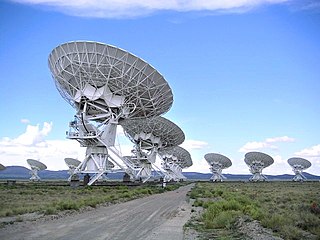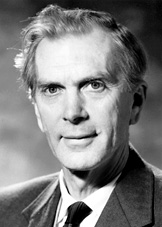
An electronic oscillator is an electronic circuit that produces a periodic, oscillating electronic signal, often a sine wave or a square wave. Oscillators convert direct current (DC) from a power supply to an alternating current (AC) signal. They are widely used in many electronic devices. Common examples of signals generated by oscillators include signals broadcast by radio and television transmitters, clock signals that regulate computers and quartz clocks, and the sounds produced by electronic beepers and video games.
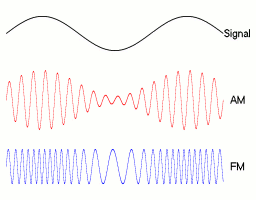
In telecommunications and signal processing, frequency modulation (FM) is the encoding of information in a carrier wave by varying the instantaneous frequency of the wave.
In electronics and telecommunications, modulation is the process of varying one or more properties of a periodic waveform, called the carrier signal, with a modulating signal that typically contains information to be transmitted. Most radio systems in the 20th century used frequency modulation (FM) or amplitude modulation (AM) for radio broadcast.

A radio telescope is a specialized antenna and radio receiver used to receive radio waves from astronomical radio sources in the sky. Radio telescopes are the main observing instrument used in radio astronomy, which studies the radio frequency portion of the electromagnetic spectrum emitted by astronomical objects, just as optical telescopes are the main observing instrument used in traditional optical astronomy which studies the light wave portion of the spectrum coming from astronomical objects. Radio telescopes are typically large parabolic ("dish") antennas similar to those employed in tracking and communicating with satellites and space probes. They may be used singly or linked together electronically in an array. Unlike optical telescopes, radio telescopes can be used in the daytime as well as at night. Since astronomical radio sources such as planets, stars, nebulas and galaxies are very far away, the radio waves coming from them are extremely weak, so radio telescopes require very large antennas to collect enough radio energy to study them, and extremely sensitive receiving equipment. Radio observatories are preferentially located far from major centers of population to avoid electromagnetic interference (EMI) from radio, television, radar, motor vehicles, and other man-made electronic devices.
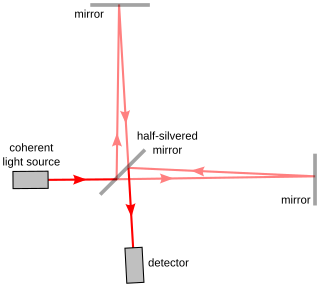
Interferometry is a family of techniques in which waves, usually electromagnetic waves, are superimposed, causing the phenomenon of interference, which is used to extract information. Interferometry is an important investigative technique in the fields of astronomy, fiber optics, engineering metrology, optical metrology, oceanography, seismology, spectroscopy, quantum mechanics, nuclear and particle physics, plasma physics, remote sensing, biomolecular interactions, surface profiling, microfluidics, mechanical stress/strain measurement, velocimetry, and optometry.
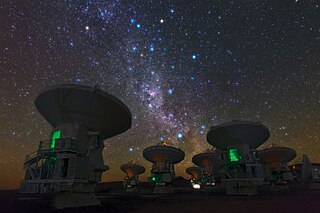
Very-long-baseline interferometry (VLBI) is a type of astronomical interferometry used in radio astronomy. In VLBI a signal from an astronomical radio source, such as a quasar, is collected at multiple radio telescopes on Earth. The distance between the radio telescopes is then calculated using the time difference between the arrivals of the radio signal at different telescopes. This allows observations of an object that are made simultaneously by many radio telescopes to be combined, emulating a telescope with a size equal to the maximum separation between the telescopes.

A power inverter, or inverter, is an electronic device or circuitry that changes direct current (DC) to alternating current (AC).
In physics, two wave sources are perfectly coherent if they have a constant phase difference and the same frequency, and the same waveform. Coherence is an ideal property of waves that enables stationary interference. It contains several distinct concepts, which are limiting cases that never quite occur in reality but allow an understanding of the physics of waves, and has become a very important concept in quantum physics. More generally, coherence describes all properties of the correlation between physical quantities of a single wave, or between several waves or wave packets.
A continuous wave or continuous waveform (CW) is an electromagnetic wave of constant amplitude and frequency, almost always a sine wave, that for mathematical analysis is considered to be of infinite duration. Continuous wave is also the name given to an early method of radio transmission, in which a sinusoidal carrier wave is switched on and off. Information is carried in the varying duration of the on and off periods of the signal, for example by Morse code in early radio. In early wireless telegraphy radio transmission, CW waves were also known as "undamped waves", to distinguish this method from damped wave signals produced by earlier spark gap type transmitters.

The Michelson interferometer is a common configuration for optical interferometry and was invented by Albert Abraham Michelson. Using a beam splitter, a light source is split into two arms. Each of those light beams is reflected back toward the beamsplitter which then combines their amplitudes using the superposition principle. The resulting interference pattern that is not directed back toward the source is typically directed to some type of photoelectric detector or camera. For different applications of the interferometer, the two light paths can be with different lengths or incorporate optical elements or even materials under test.
Aperture synthesis or synthesis imaging is a type of interferometry that mixes signals from a collection of telescopes to produce images having the same angular resolution as an instrument the size of the entire collection. At each separation and orientation, the lobe-pattern of the interferometer produces an output which is one component of the Fourier transform of the spatial distribution of the brightness of the observed object. The image of the source is produced from these measurements. Astronomical interferometers are commonly used for high-resolution optical, infrared, submillimetre and radio astronomy observations. For example, the Event Horizon Telescope project derived the first image of a black hole using aperture synthesis.

Power electronics is the application of solid-state electronics to the control and conversion of electric power.
Electronic counter-countermeasures (ECCM) is a part of electronic warfare which includes a variety of practices which attempt to reduce or eliminate the effect of electronic countermeasures (ECM) on electronic sensors aboard vehicles, ships and aircraft and weapons such as missiles. ECCM is also known as electronic protective measures (EPM), chiefly in Europe. In practice, EPM often means resistance to jamming.
An intensity interferometer is the name given to devices that use the Hanbury Brown and Twiss effect. In astronomy, the most common use of such an astronomical interferometer is to determine the apparent angular diameter of a radio source or star. If the distance to the object can then be determined by parallax or some other method, the physical diameter of the star can then be inferred. An example of an optical intensity interferometer is the Narrabri Stellar Intensity Interferometer. In quantum optics, some devices which take advantage of correlation and anti-correlation effects in beams of photons might be said to be intensity interferometers, although the term is usually reserved for observatories.
Television interference (TVI) is a particular case of electromagnetic interference which affects television reception. Many natural and man-made phenomena can disrupt the reception of television signals. These include naturally occurring and artificial spark discharges, and effects due to the operation of radio transmitters.

In radio, a detector is a device or circuit that extracts information from a modulated radio frequency current or voltage. The term dates from the first three decades of radio (1888-1918). Unlike modern radio stations which transmit sound on an uninterrupted carrier wave, early radio stations transmitted information by radiotelegraphy. The transmitter was switched on and off to produce long or short periods of radio waves, spelling out text messages in Morse code. Therefore, early radio receivers had only to distinguish between the presence or absence of a radio signal. The device that performed this function in the receiver circuit was called a detector. A variety of different detector devices, such as the coherer, electrolytic detector, magnetic detector and the crystal detector, were used during the wireless telegraphy era until superseded by vacuum tube technology.

The Ukrainian T-shaped Radio telescope, second modification is the world's largest low-frequency radio telescope at decametre wavelengths. It was completed in 1972 near the village of Hrakovo, 15 km west-south-west from Shevchenkove, Ukraine. The telescope is operated by the Institute of Radio Astronomy of the Ukrainian Academy of Sciences.
A frequency synthesizer is an electronic circuit that generates a range of frequencies from a single reference frequency. Frequency synthesizers are used in many modern devices such as radio receivers, televisions, mobile telephones, radiotelephones, walkie-talkies, CB radios, cable television converter boxes satellite receivers, and GPS systems. A frequency synthesizer may use the techniques of frequency multiplication, frequency division, direct digital synthesis, frequency mixing, and phase-locked loops to generate its frequencies. The stability and accuracy of the frequency synthesizer's output are related to the stability and accuracy of its reference frequency input. Consequently, synthesizers use stable and accurate reference frequencies, such as those provided by crystal oscillators.

The Green Bank Interferometer (GBI) is a former radio astronomy telescope located at Green Bank, West Virginia (USA) and operated by the National Radio Astronomy Observatory (NRAO). It included three on-site radio telescopes of 85-foot (26m) diameter, designated 85-1, 85-3, and 85-2 and a portable telescope.
